The NRCA Roofing Manual is a comprehensive guide for roofing professionals, offering design, material, and installation insights. Annually updated, it’s a vital resource for contractors, architects, and building owners, ensuring compliance with industry standards and best practices.

1.1 Overview of the NRCA Roofing Manual
The NRCA Roofing Manual is a detailed, annually updated resource that serves as the primary guide for roofing professionals. It covers design, materials, and installation techniques for various roof systems, ensuring compliance with industry standards. The manual is divided into sections, including steep-slope and low-slope roof systems, as well as architectural metal flashing and condensation control. It provides step-by-step construction procedures, product information, and best practices, making it an essential tool for contractors, architects, and building owners. By offering the latest technical advancements and practical insights, the manual helps ensure high-quality roofing installations and long-term performance. Its clear format and comprehensive coverage make it a cornerstone for the roofing industry.
1.2 Importance of the NRCA Roofing Manual in the Industry
The NRCA Roofing Manual is a cornerstone of the roofing industry, providing standardized guidelines that ensure high-quality installations and compliance with building codes. Its annual updates reflect the latest advancements in materials, techniques, and safety protocols, making it indispensable for professionals. By offering clear, consistent information, the manual enhances professionalism and uniformity across the industry. It serves as a vital training resource for contractors and architects, promoting best practices and adherence to industry standards. The manual’s comprehensive approach addresses both steep-slope and low-slope systems, as well as architectural metal flashing, establishing it as a trusted reference for maintaining integrity and durability in roofing projects. Its influence extends to supporting sustainable practices and innovative solutions, ensuring the industry remains progressive and competitive.
Types of Roof Systems Covered in the Manual
The NRCA Roofing Manual provides detailed coverage of steep-slope, low-slope, and architectural metal flashing systems, offering comprehensive guidance for various roofing applications and materials.
2.1 Steep-Slope Roof Systems
Steep-slope roof systems, as detailed in the NRCA Roofing Manual, are designed for roofs with a pitch greater than 3:12. These systems include materials like asphalt shingles, wood shakes, slate, and metal roofing. The manual provides extensive guidance on design considerations, such as weather resistance, structural integrity, and compatibility of roofing components. It also outlines installation techniques to ensure proper water shedding and durability. For metal roofing, the manual covers detailing for flashing, valleys, and Ridge caps. Additionally, it addresses ventilation requirements to prevent moisture accumulation and extend roof life. The NRCA Roofing Manual serves as a critical resource for contractors and architects to ensure steep-slope roofs are installed safely and effectively, meeting industry standards and best practices. Its step-by-step procedures and material recommendations make it indispensable for professionals in the field.
2.2 Low-Slope Roof Systems
Low-slope roof systems, covered extensively in the NRCA Roofing Manual, are ideal for roofs with a pitch of 3:12 or less. These systems often utilize materials such as single-ply membranes (e.g., EPDM, PVC, and TPO), modified bitumen, and built-up roofing (BUR). The manual provides detailed guidance on design considerations, including insulation, drainage, and structural load capacity. Installation techniques emphasize proper flashing, seam security, and membrane anchorage to ensure weather tightness and durability. The NRCA Roofing Manual also addresses factors like thermal expansion, condensation control, and compatibility between materials. Regular updates, such as those in the 2022 edition, reflect advancements in materials and methodologies, ensuring low-slope roofs meet modern performance standards and building codes.
2.3 Architectural Metal Flashing and Condensation Control
The NRCA Roofing Manual dedicates a section to architectural metal flashing and condensation control, emphasizing their critical role in roof system performance. Metal flashing is essential for preventing water intrusion at roof penetrations, valleys, and eaves, with detailed guidance on material selection, design, and installation techniques. The manual addresses condensation control through proper ventilation and insulation, ensuring moisture does not compromise roof integrity. It provides specifications for drip edges, gutters, and downspouts to manage water flow effectively. Additionally, it covers best practices for sealing and waterproofing to prevent leaks and structural damage. This section is vital for ensuring long-term durability and weather tightness in both steep- and low-slope roofing applications.
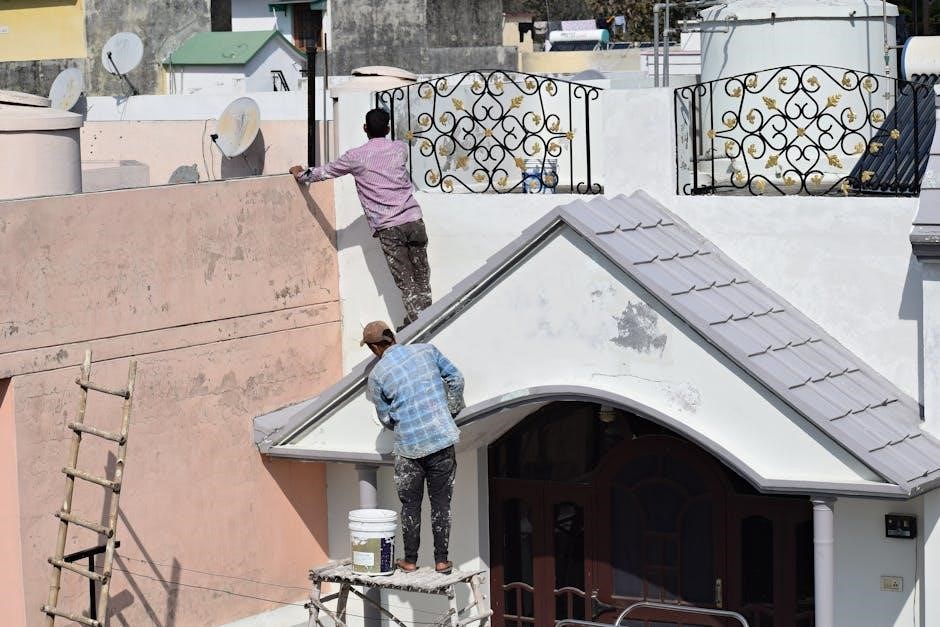
Design and Material Considerations
The NRCA Roofing Manual provides detailed insights into design principles and material selection, ensuring durability and environmental considerations for both steep- and low-slope roofing systems.
3.1 Materials for Steep-Slope Roof Systems
The NRCA Roofing Manual extensively covers materials suitable for steep-slope roof systems, including asphalt shingles, metal roofing, clay and concrete tiles, and wood shakes. These materials are chosen for their durability, weather resistance, and aesthetic appeal. The manual provides detailed specifications for each material, ensuring proper installation and long-term performance. It also emphasizes the importance of selecting materials that align with environmental and structural requirements. By adhering to the guidelines, professionals can ensure roofs withstand various climatic conditions while maintaining safety and sustainability standards.
3.2 Materials for Low-Slope Roof Systems
The NRCA Roofing Manual details materials for low-slope roof systems, such as EPDM, PVC, TPO, modified bitumen, and built-up roofing. These materials are selected for their durability and resistance to weathering, ponding water, and thermal expansion. The manual provides specifications for membrane thickness, reinforcement, and coatings to ensure optimal performance. It also highlights the importance of proper material compatibility and installation techniques to prevent issues like leaks and premature degradation. By following the manual’s guidelines, professionals can select materials that meet specific project requirements, ensuring long-term functionality and compliance with industry standards. This section is tailored to help roofing professionals make informed decisions for low-slope applications.
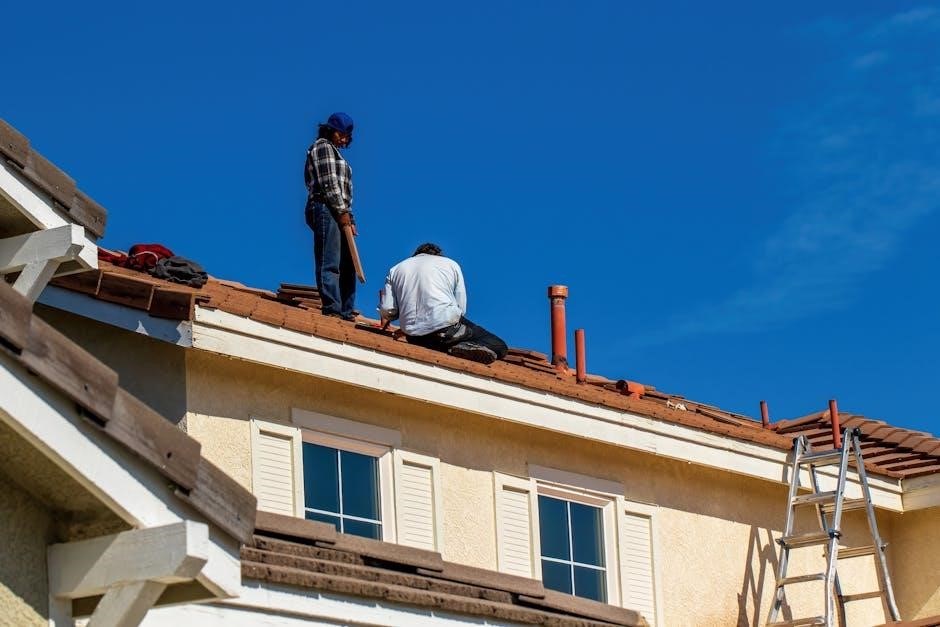
3.3 Sustainable and Environmentally Friendly Roofing Options
The NRCA Roofing Manual emphasizes sustainable roofing solutions, such as cool roofs, green roofs, and solar-integrated systems. These options reduce energy consumption and environmental impact. Cool roofs with reflective coatings lower heat absorption, while green roofs incorporate vegetation for insulation and stormwater management. Solar-integrated systems combine roofing with photovoltaic panels, generating renewable energy. The manual also highlights the use of recycled materials, such as recycled plastic and rubber, in roofing products. Additionally, it discusses strategies to minimize waste during installation and promote recyclability at the end of a roof’s life cycle. These practices align with growing demand for eco-friendly construction, helping professionals meet sustainability goals while maintaining durability and performance.
Installation Techniques
The NRCA Roofing Manual outlines detailed installation techniques for steep-slope and low-slope roofs, emphasizing safety protocols and best practices to ensure durability and weatherproofing.
4.1 Step-by-Step Installation Procedures for Steep-Slope Roofs
The NRCA Roofing Manual provides a detailed, step-by-step guide for installing steep-slope roofs, ensuring adherence to industry standards. It begins with deck preparation, including inspection and repair of any damaged areas. Next, underlayment is applied to protect the roof from weather damage. Roofing materials, such as shingles or metal, are then installed, following manufacturer specifications. Flashing is carefully placed around vents, chimneys, and valleys to prevent leaks. Finally, the roof is inspected for proper installation, and necessary finishing touches are applied. Safety measures and compliance with local building codes are emphasized throughout the process to ensure a durable and weatherproof roof system.
4.2 Best Practices for Low-Slope Roof Installation
For low-slope roof installations, the NRCA Roofing Manual emphasizes proper surface preparation and material selection. Ensure the substrate is clean, dry, and structurally sound before applying the roofing membrane. Follow manufacturer guidelines for adhesive application and membrane alignment. Install flashing at all penetrations, such as vents and drains, to prevent water infiltration. Use appropriate fastening patterns for insulation and membrane securement, and ensure all seams are tightly sealed. Conduct regular inspections during and after installation to address any defects promptly. Adhere to safety protocols, such as fall protection and proper use of equipment. Finally, perform a comprehensive inspection before final acceptance to ensure the roof meets industry standards and is ready for service.
4.3 Safety Measures During Roof Installation
The NRCA Roofing Manual strongly emphasizes safety measures during roof installation to protect workers and ensure a hazard-free environment. Always use proper fall protection equipment, such as harnesses and safety nets, when working at heights. Ensure all tools and materials are securely fastened to prevent accidental drops. Conduct regular safety inspections of ladders, scaffolding, and equipment before use. Train employees on safety protocols, including emergency procedures and first aid. Maintain clear communication among team members to avoid accidents. Use warning signs and barriers to restrict access to unsafe areas. Adhere to OSHA guidelines and industry standards for roofing operations. Regularly inspect safety equipment and replace worn or damaged items. By prioritizing safety, contractors can minimize risks and ensure a successful installation process.

Maintenance and Repair Guidelines
Regular inspections, prompt repairs, and seasonal maintenance ensure roof longevity. Inspect for wear, clean drains, and address leaks promptly. Schedule professional checks annually for optimal performance.
5.1 Regular Maintenance Tips for Roof Longevity
Regular roof maintenance is crucial for extending its lifespan. Schedule inspections during spring and fall to identify and address potential issues early. Check for missing, damaged, or loose roofing materials, and ensure all flashings are secure. Clean debris from gutters and downspouts to prevent water buildup. Inspect attic spaces for signs of moisture or structural damage. Trim tree branches near the roof to avoid abrasion; Ensure proper ventilation to prevent condensation and extend material durability. Address leaks promptly to prevent further damage. Document findings and create a maintenance schedule to track progress. Professional inspections annually can identify hidden issues and ensure compliance with industry standards. Regular care protects your investment and ensures long-term performance.
5.2 Identifying and Addressing Common Roofing Issues
Common roofing issues include damaged or missing roofing materials, leaks, and condensation buildup. Regular inspections can help identify these problems early. Look for signs of wear, such as curled or buckled shingles, cracked tiles, or torn membrane seams. Address leaks promptly to prevent structural damage. Inspect flashings around vents, skylights, and chimneys, as these are common leak sources. Condensation issues can be mitigated by ensuring proper ventilation. Use checklists to document findings and prioritize repairs. Addressing these issues promptly extends the roof’s lifespan and prevents costly repairs. Always follow NRCA guidelines for repairs to ensure durability and safety.
5.3 Tools and Equipment for Roof Maintenance
Proper tools and equipment are essential for effective roof maintenance. Common tools include utility knives, impact wrenches, and roofing hammers for repairs. Safety gear like harnesses and ladders ensure secure access. Use moisture detection devices to identify hidden leaks. For flat roofs, seam rollers and brushes are vital for membrane inspections. Power brooms and blowers help clear debris. Always use compatible materials and tools for specific roofing types. Regularly inspect and maintain equipment to ensure reliability. Refer to the NRCA Roofing Manual for recommended tools and best practices. Proper equipment ensures efficient and safe maintenance, extending roof lifespan and preventing costly damage.
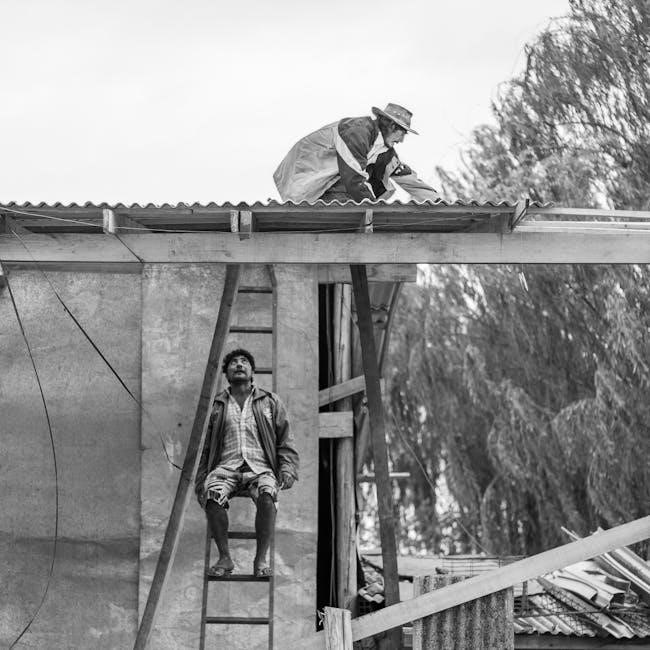
Technical Updates and Industry Standards
The NRCA Roofing Manual provides updates on roofing techniques and materials, ensuring compliance with current industry standards and regulations. Technical committees contribute to its annual revisions.
6.1 Recent Updates in the NRCA Roofing Manual
The NRCA Roofing Manual is annually updated to reflect advancements in roofing technology, materials, and installation methods. Recent updates include expanded guidelines on sustainable roofing practices, enhanced digital tools for design and maintenance, and updated best practices for membrane roofing systems. The manual now incorporates case studies highlighting successful projects that demonstrate compliance with modern building codes. Additionally, new sections focus on energy efficiency and environmentally friendly roofing solutions. These updates ensure that professionals stay informed about the latest industry trends and standards, making the manual an indispensable resource for contractors, architects, and building owners alike.
6.2 Compliance with Building Codes and Regulations
The NRCA Roofing Manual emphasizes the importance of adhering to local, state, and national building codes and regulations. It provides detailed guidance on how to ensure roofing systems meet these requirements, covering aspects such as structural integrity, fire resistance, and weatherproofing. The manual includes checklists and compliance tools to help professionals navigate complex regulatory landscapes. Regular updates in the manual reflect changes in building codes, ensuring that roofing practices remain aligned with legal and safety standards. By following the manual’s guidelines, contractors can avoid legal issues and ensure that their work meets the highest industry standards, protecting both property and occupants effectively.
6.3 Role of Technical Committees in Updating the Manual
Technical committees play a crucial role in updating the NRCA Roofing Manual, ensuring it reflects the latest industry advancements and best practices. These committees, comprised of roofing experts, manufacturers, and contractors, review and incorporate new technologies, materials, and installation methods. Their collaborative efforts ensure the manual remains comprehensive and relevant. By engaging with stakeholders, the committees gather feedback and insights, which are used to refine and improve the manual’s content. This process guarantees that updates are well-rounded and practical, addressing real-world challenges faced by roofing professionals. The committees’ contributions are essential in maintaining the manual’s authority and ensuring it continues to serve as a trusted resource for the roofing industry.
Case Studies and Real-World Applications
The NRCA Roofing Manual provides real-world insights through case studies, showcasing successful roofing projects and practical applications of its guidelines, helping professionals solve challenges effectively.
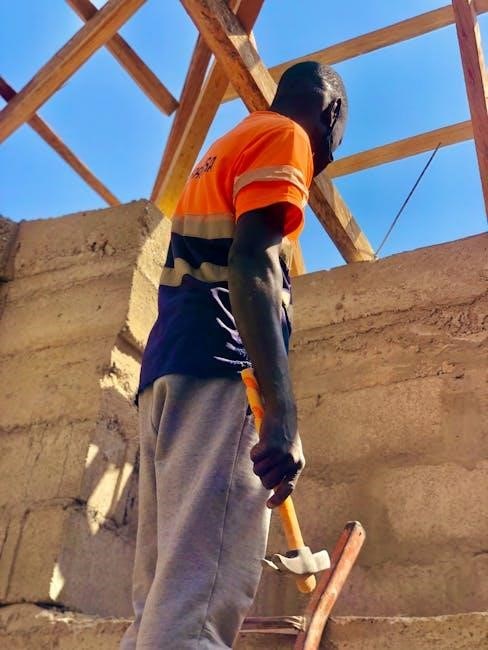
7.1 Successful Projects Using NRCA Guidelines
The NRCA Roofing Manual highlights numerous successful projects that have utilized its comprehensive guidelines to achieve exceptional roofing outcomes. These case studies showcase a variety of roofing systems, including steep-slope and low-slope designs, demonstrating how adherence to the manual ensures durability, sustainability, and compliance with industry standards. For instance, a residential steep-slope project achieved a 30-year lifespan by following material and installation recommendations. Similarly, a commercial low-slope roof incorporated energy-efficient coatings, reducing energy costs significantly. These examples illustrate the practical application of the NRCA Roofing Manual, proving its value in real-world scenarios and inspiring professionals to adopt best practices for their own projects.
7.2 Lessons Learned from Real-World Roofing Challenges
Real-world roofing challenges have provided valuable insights, emphasizing the importance of adhering to NRCA guidelines. One common issue involves material failures due to improper installation techniques, highlighting the need for strict adherence to manual recommendations. For instance, a project using modified bitumen roofing experienced premature degradation because the specified layering was not followed. Another challenge arose from inadequate condensation control measures, leading to structural damage; These experiences underscore the importance of meticulous planning, proper material selection, and regular maintenance. By addressing these challenges, professionals can enhance roofing system performance and longevity, ensuring safer and more durable structures. These lessons reinforce the NRCA Roofing Manual as an indispensable tool for overcoming real-world roofing obstacles.
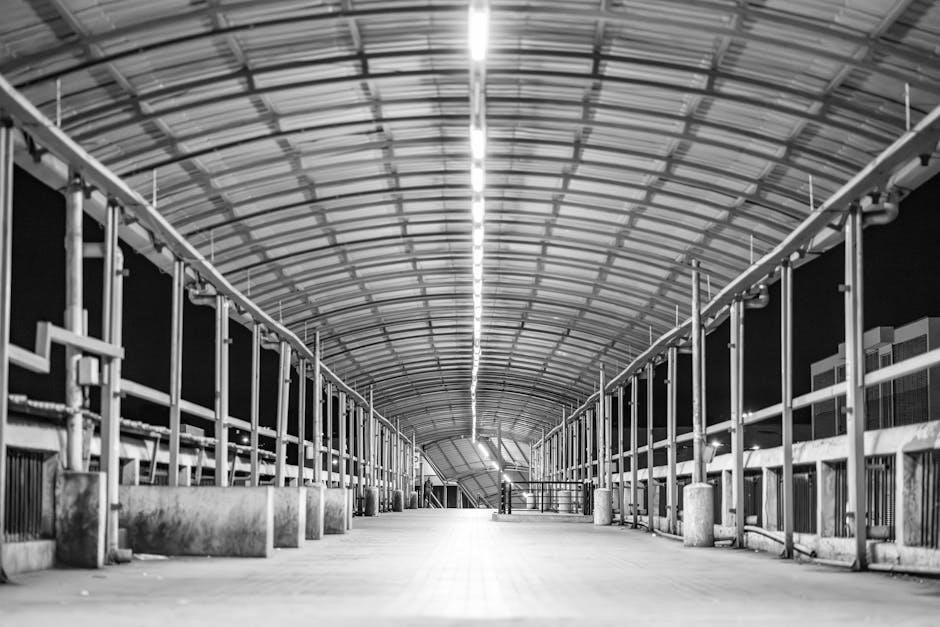
Resources and Support for Roofing Professionals

The NRCA offers extensive resources, including digital publications, training programs, and customer support, to help professionals stay updated and excel in their roofing careers.
8.1 NRCA Membership Benefits
NRCA membership provides unparalleled benefits, including free electronic access to The NRCA Roofing Manual and other digital publications. Members enjoy discounts on training, certifications, and events, enhancing their professional development. Exclusive networking opportunities, such as conferences and committees, foster industry connections and collaboration. The NRCA app offers convenient access to resources and updates, ensuring members stay informed on the latest trends and standards. Additionally, members receive support through customer service and technical assistance, addressing their specific needs. These benefits empower roofing professionals to stay competitive, compliant, and connected within the industry.
8.2 Access to Digital Publications and Tools
The NRCA offers extensive digital resources, including the NRCA Roofing Manual, through its bookstore and app. Members gain access to updated manuals, technical guides, and tools designed to streamline roofing projects. Digital publications provide step-by-step installation procedures, material specifications, and best practices for various roof systems. Additionally, the NRCA app allows users to download and reference critical information on-site, enhancing efficiency. These digital tools are regularly updated to reflect industry advancements and compliance with building codes, ensuring professionals have the most current knowledge at their fingertips. This seamless access supports informed decision-making and high-quality craftsmanship in roofing projects.
8.3 Training and Certification Programs
The NRCA provides robust training and certification programs to enhance roofing professionals’ skills and knowledge. These programs cover topics like installation techniques, material handling, and safety protocols, ensuring compliance with industry standards. Through workshops, webinars, and hands-on sessions, participants gain practical experience and theoretical understanding. Certifications, such as the Certified Roofing Estimator (CRE), demonstrate expertise and commitment to quality. These programs are designed for contractors, architects, and building owners, fostering a well-trained workforce capable of delivering high-performance roofing solutions. By staying updated with the latest trends and technologies, professionals can maintain excellence and adapt to evolving industry demands effectively.
The NRCA Roofing Manual is a cornerstone for the roofing industry, offering comprehensive updates and guiding future practices with precise, industry-essential knowledge and standards regularly.
9.1 The NRCA Roofing Manual as an Essential Resource

The NRCA Roofing Manual is a cornerstone for roofing professionals, providing comprehensive guidance on design, materials, and installation. It serves as a vital resource for contractors, architects, and building owners, ensuring compliance with industry standards. The manual is regularly updated to reflect the latest advancements and best practices, making it indispensable for staying current in the field. Its detailed, step-by-step procedures and real-world applications ensure practicality and adaptability. By addressing both steep-slope and low-slope systems, it offers universal relevance. This resource is not just a reference but a forward-thinking tool, equipping professionals to meet current and future roofing challenges effectively.
9.2 Future Trends in Roofing and the Role of the Manual
The NRCA Roofing Manual plays a pivotal role in addressing future trends in the roofing industry, such as sustainability, energy efficiency, and advanced materials. As roofing technology evolves, the manual adapts, providing updated guidelines for innovative systems like solar-integrated roofs and green roofing solutions. Its focus on best practices ensures professionals can adopt new methodologies seamlessly. The manual also emphasizes the importance of durability and environmental responsibility, aligning with growing demands for eco-friendly construction. By staying at the forefront of industry advancements, the NRCA Roofing Manual remains an indispensable tool for navigating the future of roofing, helping professionals deliver high-performance, sustainable solutions.
